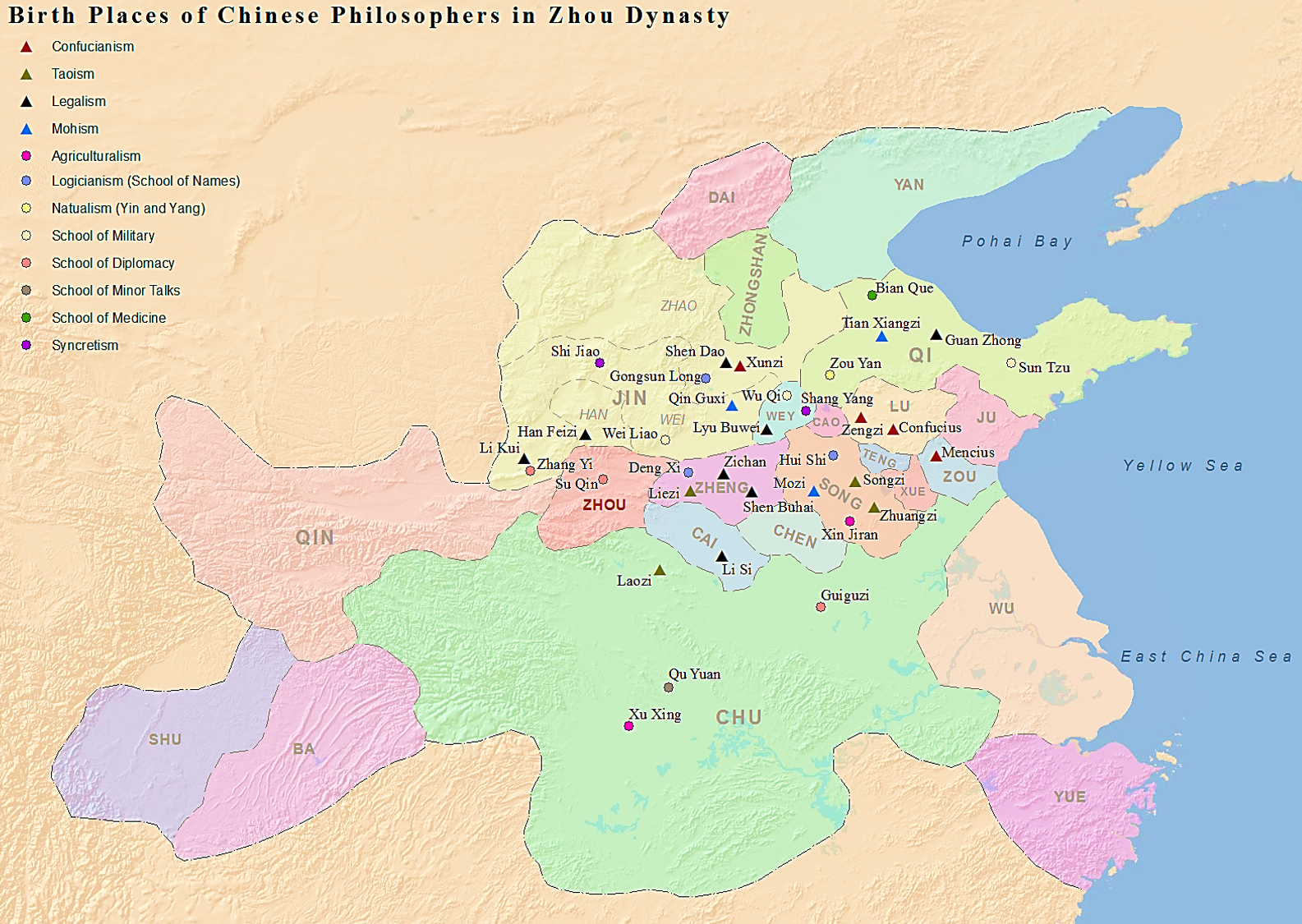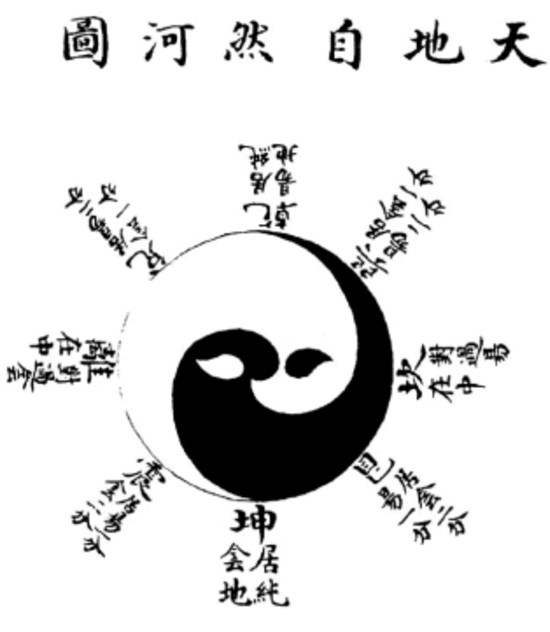|
Taijitu
In Chinese philosophy, a ''taijitu'' () is a Character (symbol), symbol or diagram () representing ''Taiji (philosophy), taiji'' () in both its monist (''Wuji (philosophy), wuji'') and its Dualism in cosmology, dualist (yin and yang) forms in application is a deductive and inductive theoretical model. Such a diagram was first introduced by Neo-Confucianism, Neo-Confucian philosopher Zhou Dunyi of the Song Dynasty in his ''Taijitu shuo'' (). The ''Daozang'', a Taoism, Taoist canon compiled during the Ming dynasty, has at least half a dozen variants of the ''taijitu''. The two most similar are the ''Taiji Xiantiandao'' and ''wujitu'' () diagrams, both of which have been extensively studied since the Qing period for their possible connection with Zhou Dunyi's ''taijitu''. Ming period author Lai Zhide simplified the ''taijitu'' to a design of two interlocking spirals with two black-and-white dots superimposed on them, became synonymous with the ''Yellow River Map''. This version wa ... [...More Info...] [...Related Items...] OR: [Wikipedia] [Google] [Baidu] [Amazon] |
Yin And Yang
Originating in Chinese philosophy, yin and yang (, ), also yinyang or yin-yang, is the concept of opposite cosmic principles or forces that interact, interconnect, and perpetuate each other. Yin and yang can be thought of as complementary and at the same time opposing forces that interact to form a dynamic system in which the whole is greater than the assembled parts and the parts are as important for the cohesion of the whole. In Chinese cosmology, the universe creates itself out of a primary chaos of primordial qi or material energy, organized into the cycles of yin and yang, force and motion leading to form and matter. "Yin" is retractive, passive and contractive in nature, while "yang" is repelling, active and expansive in principle; this dichotomy in some form, is seen in all things in nature—patterns of change and difference. For example, biological, psychological and seasonal cycles, the historical evolution of landscapes over days, weeks, years to eons. The origin ... [...More Info...] [...Related Items...] OR: [Wikipedia] [Google] [Baidu] [Amazon] |
Taoism
Taoism or Daoism (, ) is a diverse philosophical and religious tradition indigenous to China, emphasizing harmony with the Tao ( zh, p=dào, w=tao4). With a range of meaning in Chinese philosophy, translations of Tao include 'way', 'road', 'path', or 'technique', generally understood in the Taoist sense as an enigmatic process of transformation Ultimate reality, ultimately underlying reality. Taoist thought has informed the development of various practices within the Taoist tradition and beyond, including forms of Taoist meditation, meditation, Chinese astrology, astrology, qigong, feng shui, and Neidan, internal alchemy. A common goal of Taoist practice is self-cultivation, a deeper appreciation of the Tao, and more harmonious existence. Taoist ethics vary, but generally emphasize such virtues as ''wu wei, effortless action'', ziran, ''naturalness'', ''pu (Taoism), simplicity'', and the Three Treasures (Taoism), three treasures of compassion, frugality, and humility. The co ... [...More Info...] [...Related Items...] OR: [Wikipedia] [Google] [Baidu] [Amazon] |
Zhou Dunyi
Zhou Dunyi (; 1017–1073) was a Chinese cosmologist, philosopher, and writer during the Song dynasty. He conceptualized the Neo-Confucianism, Neo-Confucian cosmology of the day, explaining the relationship between human conduct and universal forces. In this way, he emphasizes that humans can master their ''qi'' ("spirit") in order to accord with nature. He was a major influence to Zhu Xi, who was the architect of Neo-Confucianism. Zhou Dunyi was mainly concerned with Taiji (philosophy), Taiji (supreme polarity) and Wuji (philosophy), Wuji (limitless potential), the yin and yang, and the Wuxing (Chinese philosophy), wu xing (the five phases). Life Born in 1017 in Dao County, Yingdao County, Daozhou prefecture, in present-day Yongzhou, southern Hunan, Zhou was originally named Zhou Dunshi. Raised by a scholar-official family, he Chinese naming taboo, changed his name in 1063 to avoid a character in the personal name of the new Emperor Yingzong of Song, Emperor Yingzong. His fa ... [...More Info...] [...Related Items...] OR: [Wikipedia] [Google] [Baidu] [Amazon] |
Lai Zhide
(; also , 1525–1604) was a Ming period Neo-Confucian philosopher. He introduced into Chinese philosophy the well-known "Yin and Yang symbol", the ''taijitu'' (a "diagram of the great ultimate"). Lai Zhide is the author of an I Ching commentary, the ''Explanation of the Classic of Change Annotated by Mr Lai'' (ed. Zheng Can 1988). See also *Li Zhi (Ming Dynasty) Li Zhi may refer to: *Emperor Gaozong of Tang (628–683), named Li Zhi, Emperor of China * Li Ye (mathematician) (1192–1279), Chinese mathematician and scholar, birth name Li Zhi * Li Zhi (philosopher) (1527–1602), Chinese philosopher from the ... * Zhou Dun-yi, an 11th-century Neo-Confucian who had also presented a ''taijitu'' References Citations Bibliography 1525 births 1604 deaths Ming dynasty philosophers Chinese Confucianists Neo-Confucian scholars Ming dynasty writers Philosophers from Chongqing Writers from Chongqing 16th-century Chinese philosophers Ming dynasty classicists {{Ne ... [...More Info...] [...Related Items...] OR: [Wikipedia] [Google] [Baidu] [Amazon] |
Taiji (philosophy)
In Chinese philosophy, ''taiji'' () is a cosmological state of the universe and its affairs on all levels—including the mutually reinforcing interactions between the two opposing forces of yin and yang (a dualistic monism), as well as that among the Three Treasures, the four cardinal directions, and the Five Elements—which together ultimately bring about the myriad things, each with their own nature. The concept of ''taiji'' has reappeared throughout the technological, religious, and philosophical history of the Sinosphere, finding concrete application in techniques developed in acupuncture and traditional Chinese medicine. Etymology ''Taiji'' () is a compound of ''tai'' ( 'great', 'supreme') and ''ji'' ( 'pole', 'extremity'). Used together, ''taiji'' may be understood as 'source of the world'. Common English translations of ''taiji'' in the cosmological sense include "Supreme Ultimate", "Supreme Pole", and "Great Absolute". Core concept Scholars Zhang and Ryden e ... [...More Info...] [...Related Items...] OR: [Wikipedia] [Google] [Baidu] [Amazon] |
Bagua
The ''bagua'' ( zh, c=八卦, p=bāguà, l=eight trigrams) is a set of symbols from China intended to illustrate the nature of reality as being composed of mutually opposing forces reinforcing one another. ''Bagua'' is a group of trigrams—composed of three lines, each either "broken" or "unbroken", which represent yin and yang, respectively. Each line having two possible states allows for a total of 23 = 8 trigrams, whose early enumeration and characterization in China has had an effect on the history of Chinese philosophy and cosmology. The trigrams are related to the divination practice as described within the ''I Ching'' and practiced as part of the Shang and Zhou state religion, as well as with the concepts of '' taiji'' and the five elements within traditional Chinese metaphysics. The trigrams have correspondences in astronomy, divination, meditation, astrology, geography, geomancy (feng shui), anatomy, decorative arts, the family, martial arts (particularly tai chi an ... [...More Info...] [...Related Items...] OR: [Wikipedia] [Google] [Baidu] [Amazon] |
Western Zhou
The Western Zhou ( zh, c=西周, p=Xīzhōu; 771 BC) was a period of Chinese history corresponding roughly to the first half of the Zhou dynasty. It began when King Wu of Zhou overthrew the Shang dynasty at the Battle of Muye and ended in 771 BC when Quanrong pastoralists sacked the Zhou capital at Haojing and killed King You of Zhou. The "Western" label for the period refers to the location of the Zhou royal capitals, which were clustered in the Wei River valley near present-day Xi'an. The early Zhou state was ascendant for about 75 years; thereafter, it gradually lost power. The former lands of the Shang were divided into Ancient Chinese states, hereditary fiefs that became increasingly independent of the Zhou king over time. The Zhou court was driven out of the Wei River valley in 771 BC: this marked the beginning of the Eastern Zhou period, wherein political power was wielded in actuality by the king's nominal vassals. Sources The Western Zhou are known from ... [...More Info...] [...Related Items...] OR: [Wikipedia] [Google] [Baidu] [Amazon] |
I Ching
The ''I Ching'' or ''Yijing'' ( ), usually translated ''Book of Changes'' or ''Classic of Changes'', is an ancient Chinese divination text that is among the oldest of the Chinese classics. The ''I Ching'' was originally a divination manual in the Western Zhou period (1000–750 BC). Over the course of the Warring States period, Warring States and early imperial periods (500–200 BC), it transformed into a Religious cosmology, cosmological text with a series of philosophical commentaries known as the Ten Wings. After becoming part of the Chinese Five Classics in the 2nd century BC, the ''I Ching'' was the basis for divination practice for centuries across the Far East and was the subject of scholarly commentary. Between the 18th and 20th centuries, it took on an influential role in Western understanding of East Asian philosophical thought. As a divination text, the ''I Ching'' is used for a Chinese form of cleromancy known as I Ching divination, ''I Ching'' div ... [...More Info...] [...Related Items...] OR: [Wikipedia] [Google] [Baidu] [Amazon] |
European Prehistory
Prehistoric Europe refers to Europe before the start of written records, beginning in the Lower Paleolithic. As history progresses, considerable regional unevenness in cultural development emerges and grows. The region of the eastern Mediterranean is, due to its geographic proximity, greatly influenced and inspired by the classical Middle Eastern civilizations, and adopts and develops the earliest systems of communal organization and writing. The Histories of Herodotus (from around 440 BC) is the oldest known European text that seeks to systematically record traditions, public affairs and notable events. Overview Widely dispersed, isolated finds of individual fossils of bone fragments (Atapuerca, Mauer mandible), stone artifacts or assemblages suggest that during the Lower Paleolithic, spanning from 3 million until 300,000 years ago, palaeo-human presence was rare and typically separated by thousands of years. The karstic region of the Atapuerca Mountains in Spain repres ... [...More Info...] [...Related Items...] OR: [Wikipedia] [Google] [Baidu] [Amazon] |





